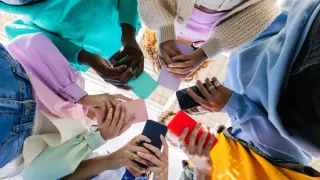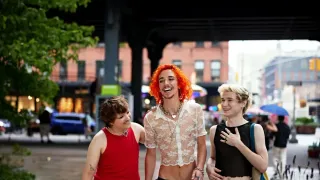November 18, 2014
Queer/Film Culture :: The Assimilation Game
James Nadeau READ TIME: 6 MIN.
One of the big questions I get asked as the director of an LGBT film festival is, "Why?" As in, "Why do we need a festival for gay films?," implying that the need for such a thing no longer exists.
This is especially true in a place like Massachusetts. We were the first state to have gay marriage, therefore aren't we, as a group, better off? Haven't we become part of the mainstream? We celebrated 10 years of gay marriage this past summer. Our community has dispersed and entered suburbia. We are married with children and assimilating into greater culture. Our centers of queer life no longer exist as they have historically. The South End can no longer be seen as the bastion of Boston queer life much as others such as the East Village in NYC or the Castro in San Francisco have seen their gay populations disperse and disappear.
In this context, how do we place or situate queer cinema? I want to skip the argument about the "whys" of queer festivals and instead examine queer cinema in the context of assumed assimilation. I qualify assimilation with the term "assumed" simply because assimilation is never a definitive. It is based upon an interpretation of one's status, the presumption being that since we have gay marriage you are therefore assimilated. I will also sidestep what is problematic about this statement for the time being. I'm much more interested in how this presumed assimilation gets presented in cinema.
The 1990s: 'In Your Face'
The conceit that a character in a film can exist simply as a character and not as a "gay" character has been around for some time. We are distanced both in time and perception from the era of the early 1990s, where New Queer Cinema reigned.
Films from that era are marked by a blatant, "in your face" queerness that current filmmakers seem to eschew (at least in the U.S.). Granted, it was a very different time culturally and politically. Being out was a political statement in the late 1980s and early 1990s, and that was the power of these films' images. They were unapologetically queer. In some ways it was their raison d'etre. They functioned as an artistic statement, and a political one. In light of the AIDS crises, proclaiming one's identity was powerful and necessary. It forced others to acknowledge that we existed.
Today's cinematic portrayals function very differently. Within the North American and western European cannon, queer portrayals have moved beyond the narratives of identity politics. There are some exceptions to this rule, which I'll touch upon in a moment. What does it mean when filmmakers say that they have characters who happen to be gay but aren't gay characters? It seems like a linguistic ploy (and it might be - these are writers after all), but the reality is that for these films the focal point of the narrative is no longer about "gayness," but about the character and the character happens to be gay. I find this stance to be somewhat problematic.
Post-Gay World?
The desire to operate in a "post-gay" world can function as a means to eliminate history. I sometimes think of this in the same context as people who prefer to think of us as living in a "post racial" society. The reality is that this just isn't true. There will always be queer and non-queer. So how are these narratives functioning? Are they dream states? The characters exist in a world where being gay isn't a cog in a dramatic arc. And for many people (within this particular geographic purview), that might very well be true.
For many of us, being out and queer is the least of our concerns, but it doesn't mean that we aren't having to always come out as queer. It can sometimes be dramatic whether you are coming out to the guy at the hot dog stand that gives you a look, simply paying a phone bill, or having to explain that you have a family plan with another person of the same sex. Coming out is a constant activity. It isn't "one and done." That is simply the reality of living in our society.
Straight-Approved Assimilation
So these films represent an idealized state. For example, there is the film "The 10 Year Plan," directed by J.C. Calciano.
Many of J.C's films operate in a world where a character's gayness is irrelevant, yet the narrative revolves around a character finding happiness with a person of the same sex. Pretty straightforward, right? He is an out gay filmmaker telling stories about gay characters.
In this particular film, the two main protagonists made a deal that if neither is in a relationship in ten years, then they'll partner up. They are surrounded and supported by a cast of straight characters. What is interesting is that while the main characters are two gay guys (one of whom is a notorious Lothario, the other uptight and straightlaced), the relationship between the two men is counter-balanced by the straight characters that provide guidance in how relationships function.
So the relationship is predicated upon its connections to and support from the heterosexual characters. It reads as a case of assimilation dependent upon approval and acceptance by the straight community.
Cultural Dislocation
A more interesting case study would be the British film "Lilting," directed by Hong Khaou. This narrative revolves around a Cambodian-Chinese mother, Junn, who is mourning her dead son, Kai. Her son's white, British boyfriend, Richard, attempts to connect to her, despite the linguistic and cultural differences between them. The mother is also unaware of her son's homosexuality and the fact that this person (a complete stranger to her) is trying to connect to her as a means of remembering her son.
While the central conceit of the story is one of "coming out," in many ways the film deals with the sexuality as a surrogate for cultural dislocation. They both loved Kai, but Junn is displaced by an inability to communicate. She is separated by culture and language. The revealing, "the coming out," when it occurs late in the film, is secondary. Ultimately the film is the story of communication and lost opportunities. While seemingly about gayness and coming out, these are merely dramatic turns. Richard and Kai's homosexuality is a given, and not remarked upon. It is the cultural differences between the mother and son that drive the plot. Richard is gay. Kai is gay. It is the loss between all three that carries the story. The film resists the idealization of contemporary society. This is no dream land.
I think by looking at these two films in relation to each other, we can see just a couple ways in which the assimilation narrative can play out. We are hitting a cultural moment where the stories of people who "just happen" to be gay are emerging all over the place. But the trick is how to tell stories that ring authentic?
The idealized world where one's sexual or gender identity is irrelevant seems na�ve. While LGBT people can certainly hide in the closet and pick a time and a place to be present, cinema offers up an opportunity to explore what it means to have to or not have to do this. And the remarkable thing about film is its ability to tell these stories that, in many ways, offer up paths to figure out ourselves, and to do so on our terms. J.C. Calciano's gay world is certainly enviable. We should aim for an existence where who we loved is irrelevant. But I like the fact that film gives us many options for exploring possible outcomes.






